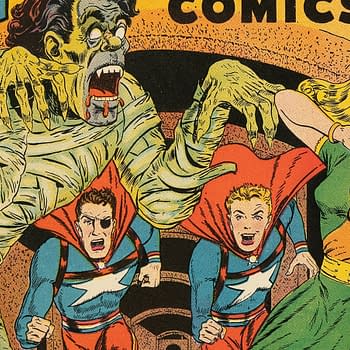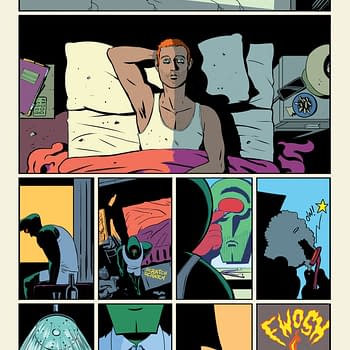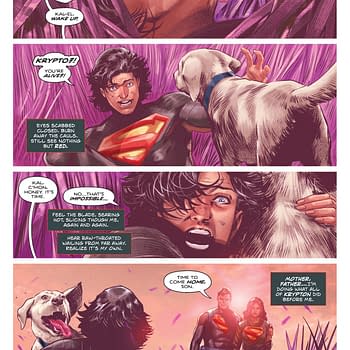Posted in: Comics, Recent Updates | Tagged: trina robbins
Meeting Golden Age Art Goddess, Lily Renée
BC forum moderator Lexid523 and Ladies Making Comics blogger writes:
This past Sunday, I had a once in a lifetime opportunity to meet two women I have admired ever since I started delving into ladies' comics history.
First was Trina Robbins, the revolutionary underground cartoonist and quintessential comics "herstorian", whose books on the history of women in comics and cartooning, female superheroes, and comics aimed at girls and women are ground zero for most research in this field.
Second was one of the very first pioneers of women in comic books, Lily Renée Phillips, who had grown up in an affluent Viennese Jewish family, escaped to England after the Anschluss, before ending up in New York City with nothing but her artistic skills to support herself and her family, becoming (in my opinion) one of the best comics artists of the Golden Age.
Trina and Lily appeared together at the Books of Wonder children's bookstore in Manhattan, to talk about Lily's amazing life and career, and to sign the graphic biography Trina had done with artist Anne Timmons about Lily. From the moment Trina first e-mailed me about the event over a month ago, I knew not a force in the universe could stop me from going.
Fortunately, all it ever takes to get to New York from Boston is $15 and 4 hours, and I had both of those on Sunday.
After arriving at the store an hour early, I re-energized with a scone and a cup of tea in the store's adorable little café. I got psyched up rifling through the books I had brought for both women to sign—the Lily Renée: Escape Artist book, of course, which had been graciously given to me by my SPX panel-mate Robyn Chapman, who works for the publisher; Trina's histories; and for Lily, though her comics are out of my price range, I had gotten my hands on a book she had illustrated in the '70s, The Battle of the Bees.
With 15 minutes to go, I wandered over to the corner of the store where the event was being held— a gorgeous nook covered in the prints of famous childrens' book covers, and antique and rare books along one wall, and much to my excitement, it was filled with people attending the event. And at the front, talking animatedly with one of the event organizers was my long-time muse of comics herstory and occasional e-mail correspondent, Trina Robbins.
With grace and aplomb, I shuffled forward, stuck out my hand, and said, "Hi. Um, I run that blog." Smooth. Trina seemed not to notice and embraced me like a long-lost granddaughter, and we chatted briefly before someone offered to take our picture (see above). Lily had not arrived yet and Trina was still trying to figure out how to position the table and run the PowerPoint from it, so I took the best seat still available.
While waiting for the event to get started, I had a nice chat with Jewish author Erika Dreifus, who found out about the event from the Jewish Book Council blog; she also was planning on going to an Art Spiegelman event the next day. I had a good chuckle when she apologized for not being very familiar with comics— I'm so used to having to defend comics to people unfamiliar with them, it was funny having the reverse happen!
Lily and Trina; photo by R. Robert Pollak
Lily soon arrived and everyone soon settled in to listen to Trina's presentation, with Lily's occasional comments, of her remarkable life. One of the first images to really strike me was a picture of an adolescent Lily with her mother, a friend of her mother's, and that woman's daughter. Lily explained that her mother's friend—also Jewish—later managed to survive the concentration camps, because she was a doctor. One key tragic fact that almost always gets left out of Holocaust narratives is that Germanic Europe before the rise of the Nazis was one of the most socially progressive areas in the world at the time, with rampant women's liberation and a thriving queer community.
As Trina went through the slides, sometimes Lily had a lot to say, but some, as with a picture of the wreckage following Kristallnacht, she had nothing to add. Though later, after talking about her time in England and going through the Blitz, she mentioned that she became very good at drawing ruins. She also talked about working as a maternity ward nurse in Leeds during that time, and the sense of purpose it gave her to protect the babies and bring them to the bomb shelter.
Lily was eventually reunited with her family in New York City, and she talked about drawing products for the Woolworth's catalog for 50 cents an hour. She made a point to say that, "at the time the subway cost a nickel, so 50 cents was more then. But it was still only 50 cents an hour." As a very beautiful young woman, she also modeled, even getting a photo in Vogue, though her most high-profile modeling gig was when a department store made a cast of her head to use on their mannequins. "People would stop me in the street and say, 'I know you!' But they didn't know me, they knew my mannequins."
Then finally Trina and Lily got to talking about the fateful day her mother found an ad in the newspaper looking for comic book artists. Lily mentioned how she had never seen a comic book before then— the closest she had gotten was the classic German children's book Max und Moritz. She talked about going to the Fiction House offices, being the only woman there, and the owner laughing and rocking in his chair as he looked through her portfolio. For whatever reason he was laughing, he hired her. Things did not get much better as she worked— she talked about all the men at the office (most of them fairly young themselves) making suggestive comments and trying to "teach" her English—the dirty words. She cried herself to sleep for nights on end, but the pay was too good to give it up.
Trina brought the conversation back around to the wonderful strong female characters she got to draw, and how Lily got to draw women fighting Nazis— an observation that made Lily smile. Lily also talked about working out story ideas with the writer for her supernatural title "The Werewolf Hunter", since she didn't think much of her skills of drawing wolves. So they made it more of a general gothic horror title.
After taking a few questions, they opened up the table for signings. I stepped up first to shake Lily's hand and introduced myself far more gracefully than I had with Trina. I told her how much I loved her art and how much I was looking forward to the collection Trina is putting together. I then asked her to sign my books. She did my favorite thing creators can do when you give them work of theirs to sign— she complained about how Battle of the Bees was formatted and how some of her drawings were cropped or had type placed in the negative space, which was not her intention for those drawings. I love it when artists explain what went wrong with a book when all you can see is what went right.
Two of my most prized possessions
I had a similar fangasm with Trina, talking about women in the history of comics, and how sad it is that the Big Two largely ignore such a rich aspect of their history. She thanked me for starting the Women in Comics Wiki, which as I told her, could not have existed without her "herstories".
I meant to stick around longer and get a picture with Lily, maybe talk to her granddaughter who was there (and who was the one who first contacted Trina letting her know that Lily Renée was indeed still alive and well, and had such a remarkable life story), but alas I had work the next day, and a deal with my mother that I'd never be alone in New York after dark, so I had to get back to Penn Station to catch my bus. It was a boomerang trip, I barely ate anything all day, the bus ride home was cramped, and I was exhausted when I finally got back into my apartment. But it was one of the best days of my life.
Rangers Comics #40, April 1948
The Werewolf Hunter pencils & inks by Lily Renée
Planet Comics #32, September 1944
The Lost World, pencils & inks by Lily Renée



































